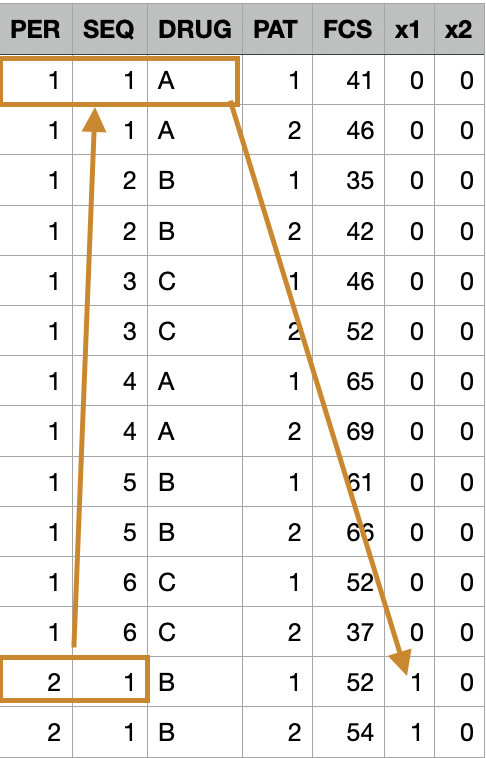Late Dr. Steve Arnold (Penn State), came up with a satisfactory solution to account for carry-over effects in the data analysis. The following example will illustrate how the procedure works.
Psychiatrists want to evaluate the effect of three drugs on severe post-traumatic stress disorder (PTSD) symptoms. The three drugs are administered to each patient in a sequence over three periods. The change in each patient's functional capability score (FCS) from baseline is recorded at the end of each period. A total of six sequences were used and two patients were assigned to each sequence of treatments.
The cross-over design can be summarized as:
Period | |||
|---|---|---|---|
Sequence | 1 | 2 | 3 |
1 | A | B | C |
2 | B | C | A |
3 | C | A | B |
4 | A | C | B |
5 | B | A | C |
6 | C | B | A |
If we look at the first part of the dataset (Psychiatry Data), we can see the following:
PER | SEQ | DRUG | PAT | FCS |
|---|---|---|---|---|
1 | 1 | A | 1 | 41 |
1 | 1 | A | 2 | 46 |
1 | 2 | B | 1 | 35 |
1 | 2 | B | 2 | 42 |
1 | 3 | C | 1 | 46 |
1 | 3 | C | 2 | 52 |
1 | 4 | A | 1 | 65 |
1 | 4 | A | 2 | 69 |
1 | 5 | B | 1 | 61 |
1 | 5 | B | 2 | 66 |
1 | 6 | C | 1 | 52 |
1 | 6 | C | 2 | 37 |
2 | 1 | B | 1 | 52 |
2 | 1 | B | 2 | 54 |
2 | 2 | C | 1 | 33 |
2 | 2 | C | 2 | 36 |
2 | 3 | A | 1 | 46 |
2 | 3 | A | 2 | 47 |
2 | 4 | C | 1 | 39 |
We need now to add two columns to use an effect-type coding for the 3 treatment levels. We define the following coding:
A | \(x_1\) | \(x_2\) |
|---|---|---|
1 | 0 | |
B | 0 | 1 |
C | -1 | -1 |
Here \(x_1\) and \(x_2\) will be columns we create in the data to input for all of the rows of data. The coding values depend on which treatment level is administered during the previous period. For example, if treatment A was administered in the previous period, then coding values would be \(x_1=1, x_2=0\).
There will be no entries for the first period because on the first application of each treatment there are no treatments that have preceded it. Therefore a 0 is used as the coding value for both \(x_1\) and \(x_2\). The augmented dataset will be the following:
PER | SEQ | DRUG | PAT | FCS | x1 | x2 |
|---|---|---|---|---|---|---|
1 | 1 | A | 1 | 41 | 0 | 0 |
1 | 1 | A | 2 | 46 | 0 | 0 |
1 | 2 | B | 1 | 35 | 0 | 0 |
1 | 2 | B | 2 | 42 | 0 | 0 |
1 | 3 | C | 1 | 46 | 0 | 0 |
1 | 3 | C | 2 | 52 | 0 | 0 |
1 | 4 | A | 1 | 65 | 0 | 0 |
1 | 4 | A | 2 | 69 | 0 | 0 |
1 | 5 | B | 1 | 61 | 0 | 0 |
1 | 5 | B | 2 | 66 | 0 | 0 |
1 | 6 | C | 1 | 52 | 0 | 0 |
1 | 6 | C | 2 | 37 | 0 | 0 |
2 | 1 | B | 1 | 52 | 1 | 0 |
2 | 1 | B | 2 | 54 | 1 | 0 |
2 | 2 | C | 1 | 33 | 0 | 1 |
2 | 2 | C | 2 | 36 | 0 | 1 |
2 | 3 | A | 1 | 46 | -1 | -1 |
2 | 3 | A | 2 | 47 | -1 | -1 |
2 | 4 | C | 1 | 39 | 1 | 0 |
Looking at Period 2, sequence 1, treatment B, we can refer back to the Sequence chart and see that it was preceded by treatment level A, so we assign \(x_1 = 1\), and \(x_2 = 0\), indicating that it was treatment A that could produce a carry-over effect here.

The process can be repeated to define the coding variables for each entry in the dataset. The coded variables \(x_1\) and \(x_2\) are then entered into the general linear model as continuous covariates and LSmeans for treatments are adjusted for carry-over effects.